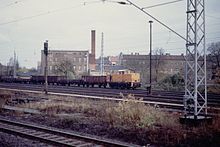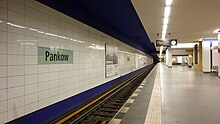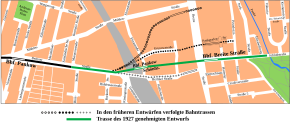Berlin-Pankow train station
| Berlin-Pankow | |
|---|---|
|
Reception building, 2015
|
|
| Data | |
| Location in the network | Intermediate station |
| Design | Through station |
| Platform tracks | 2 |
| abbreviation | BPKR (formerly Rbf) BPKW (S-Bahn station) |
| IBNR | 8089080 |
| Price range | 5 |
| opening | October 15, 1880 (passenger station) October 1, 1893 (marshalling yard) |
| Conveyance | July 2, 1997 (marshalling yard) |
| Website URL | s-bahn-berlin.de |
| Profile on Bahnhof.de | Berlin-Pankow |
| Architectural data | |
| architect |
Karl Cornelius Ernst Schwartz Lücking |
| location | |
| City / municipality | Berlin |
| Place / district | Pankow |
| country | Berlin |
| Country | Germany |
| Coordinates | 52 ° 34 '0 " N , 13 ° 24' 40" E |
| Railway lines | |
|
|
| Railway stations in Berlin | |
The name Bahnhof Berlin-Pankow is used for an S-Bahn and an underground station in the Pankow district of the Berlin district of the same name . The stations are located at the intersection of the Stettiner Bahn and Berliner Straße , which provides the fastest connection between the Pankow district and the historic center of Berlin . The name Berlin-Pankow refers to both the marshalling yard, which was closed in 1997, and the S-Bahn station, but they are two independent operating locations .
Station complex
S-Bahn station
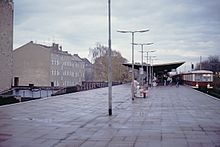
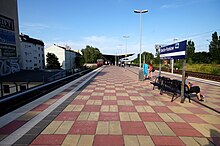
The municipality of Pankow, which was independent until 1920, was the next larger settlement on the route to Stettin when the railway was built . Although the place was said to be important as a summer retreat and excursion destination, the first stop was in Bernau, 18 kilometers further away . Not until October 15, 1880 was a stop set up in Pankow. The center of Pankow was almost a kilometer from the train station on the road to Berlin. In the early years of the railway, the area around the station was thus far outside, but was soon settled under the influence of the station. Today's Pankow station was renamed Pankow-Schönhausen shortly after it opened . This name referred to the nearby Schönhausen Palace in the nearby Niederschönhausen . The nearby station of the Berlin Northern Railway (today: Wollankstrasse Station ) was named 'Bahnhof Pankow' .
With the construction of the Pankow marshalling yard, the passenger station was also rebuilt. Until 1916, suburban traffic was separated from long-distance and freight traffic on the Szczecin Railway to Bernau . The new pair of tracks for long-distance and freight traffic went into operation between the previous line and the marshalling yard and was structurally taken into account in its layout. As part of the expansion, a new station building was also built on the north side from 1909 to 1914 according to plans by Karl Cornelius and Ernst Schwartz . A good ten years later, electrical operation was tested on the entire suburban route. Based on the electrification decision in 1913, the Deutsche Reichsbahn still intended to operate overhead lines and 15 kilovolts 16 2 ⁄ 3 Hertz alternating voltage until 1922 . At the beginning of 1921, twelve masts were erected at a distance of around 100 meters between the Pankow and Pankow-Heinersdorf stations . The Reichsbahndirektion, however, decided on the operation with a lateral conductor rail, which is still common today for the Berlin S-Bahn . The converter plant was built in Pankow for the power supply . On August 8, 1924, regular electrical operation could begin.
The effects of World War II on the station complex were minor. The destruction included the old station building on Berliner Strasse south of the long-distance tracks. Since October 3, 1954, the station has been called 'Berlin-Pankow'.
On the occasion of the construction of the underground station, the area around the station was redesigned and the S-Bahn station renovated from 2003. The platform edges were renewed for this purpose. The bridges over Berliner Straße were replaced by new buildings. First, the covering of the S-Bahn tracks was renewed in 2003/04, and the superstructure of the long-distance railway was installed in 2005. The old overpasses to the marshalling yard were demolished in 2008.
Former marshalling yard
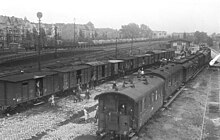
A one-sided marshalling yard with two entry and exit groups as well as one directional group followed on the east side of the continuous line to the north of the passenger station , which after the Second World War had a wagon switching capacity of up to 1,800 freight wagons per day. Before the Second World War, the output was sometimes even higher, so in 1917 a daily output of over 3800 wagons was achieved, making Pankow the largest one-sided marshalling yard in the German Reich .
The facility was built from 1891 to 1893 for 8.9 million marks (adjusted for purchasing power in today's currency: around 62 million euros). Of this, 5.5 million marks (around 38 million euros) went to the station itself, the other costs were used, among other things, for the connections. Its construction became necessary because the freight transport facilities of the Szczecin train station in Berlin were no longer sufficient for the increased volume of traffic. Freight trains to Berlin first called at the Szczecin station, where the wagons were separated into local and transitional goods, the local freight wagons were unloaded at the station, while the transitional wagons were departed via Gesundbrunnen station and the Ringbahn . In the opposite direction, the wagons for the Szczecin Railway were collected at the Szczecin train station and then left closed. In 1888 the station recorded 600 axles driven daily in transit traffic, plus 470 axles in local traffic. 70 axles of unloaded goods and 290 axles of flaked and transhipped goods were recorded at the exit every day. On the nights from Saturday to Saturday, cattle trains from Pomerania were also converted for the Centralviehhof station . The terminus station proved to be undersized for this traffic, and there was also the extraordinary load on the section between the Szczecin station and the Gesundbrunnen station.
The creation of a separate marshalling yard was intended to relieve the terminal station from freight traffic to a large extent and create sufficient construction space for the expansion of the passenger station. The new station was to be the starting and ending point for the freight trains of the Szczecin and Northern Railways, and the goods destined for the two routes by the Ringbahn were to be supplied via the marshalling yard. The plans provided for an area east of the existing route between Berliner Straße and Gut Blankenburg. For the expected shunting traffic, the Berliner Straße crossing at the southwest end and the Mühlenstraße further to the west had to be passed under the railway without crossing. In addition, Prenzlauer Chaussee had to be crossed over the facilities (“Black Bridge”), Damerowstraße was interrupted by the train station and brought up to the Chaussee on the north side. The station was connected to the Stettiner Bahn at the northeast end and to the Stettiner, Ring- and Nordbahn at the southwest end. The connecting curves to the last two routes mentioned went into operation in autumn 1896 and on May 1, 1897. With 73 incoming and just as many outgoing freight trains every day, around 8,400 axles were counted in the entry and exit areas.
Even before the construction, freight traffic had grown so much that in 1889 it was decided to build an auxiliary station. This was laid out between the Blankenburg and Karow stations and handed over to its destination in January 1890. The station was still in operation until at least 1903 and sometimes served as a front station for Pankow.
Starting from the southwest, the station had six entry tracks, which were also drainage tracks. The cars then ran in two directional groups with six tracks each. The individual directions were: Nordbahn , Nordbahnhof , Ringbahn Ost , Ringbahn West, Stettiner Bahn and Stettiner Bahnhof. From the direction group, the wagons were then pulled into the tracks at the north end of the station and from there pushed into two further groups for distribution to stations and parts of the station. Completely formed trains were shunted from there to the collecting tracks west of the direction group, which was connected to the exit on both sides. A collection group for empty wagons and a separate track group with an attached transshipment hall completed the system. At the southwest end, facilities for local freight traffic were set up. At the north end, the Berlin-Pankow depot was built with a 24-hour round shed and an initially six-hour roundhouse. At the same time as the marshalling yard, the Pankow-Heinersdorf stop was opened on October 1, 1893, and access to the marshalling yard and the depot was created from the reception building.
The marshalling yard was hit several times by aerial bombs as a strategically important target during the Second World War , but initially there was no significant damage. The expansion of the attacks towards the end of the war ultimately led to extensive restrictions on rail operations. During a British air raid on April 3, 1945, a transport train was hit and the ammunition inside detonated. With the advance of the front in the course of the Battle of Berlin , the Reichsbahner were sent home on April 20, 1945. In the ensuing fighting, the station came under artillery fire , and several ammunition wagons caught fire. On April 23, 1945 the front had passed through Pankow.
On May 4, 1945, the Reichsbahner resumed service, which was initially under the administration of SMAD and was handed over to the Deutsche Reichsbahn in 1945 . The first work concerned the repair of the damage and the filling of the bomb craters . Operation was resumed in the autumn of the same year. In the 1950s and 1960s, the station was gradually modernized, including replacing the mechanical signal boxes with electromechanical signal boxes. The illumination of the HF form signals was initially switched from petroleum to propane , later to electrical illumination and finally the signals were replaced by Hl signals . The Reichsbahn replaced the telegraph lines and Morse code machines with train signaling and station intercom systems. The station lighting was replaced by HQL lamps . The originally blunt-ended directional group at the north end of the station was connected to the long-distance tracks in the direction of Blankenburg via the Pka signal box. Around 1960 Pankow's drainage capacity was around 1700 cars. In the 1970s, track brakes were put into operation for operational operations, replacing the previous drag brakes . An electric point heating system using a decommissioned electric locomotive as a transformer made winter service easier.
In addition to the two loading streets (1 from Berliner Straße) and (2 from Granitzstraße) accessible for food or coal and building materials, there was a pallet handling point for large pallets with prefabricated concrete walls for the GDR's housing program , facilities for road scooters and a waste handling facility north of the railway depot the city cleaning . Various siding , including for coal and scrap dealers, completed the picture.
The freight and marshalling yard, which was important in GDR times, lost more and more of its importance after the political change . On July 2, 1997, it was finally shut down. By 2007, the entire track system and some buildings were demolished.
In 2009, the 250,000 square meter area was acquired by the investor Kurt Krieger , who wants to build a shopping center with a furniture store and a park area there.
- Pankow marshalling yard
Subway station
The plans to open up Pankow with a subway go back over 70 years. With the extension of line A of the Berlin subway (today's line U2 ) to Pankow (Vinetastraße) , the first opportunity arose, but the global economic crisis thwarted the plan. In the following years there were further plans for an underground station. Since the respective builders disagreed about the sources of money, the exact location of the station and any continuation of the route, the plans stayed in the drawers.
In the mid-1980s, plans arose for a company workshop on the strip of land between the marshalling yard and Granitzstrasse as far as the Prenzlauer Promenade. The reason for this was the extension of line E to Hönow and the associated increased utilization of the Friedrichsfelde workshop . The facility was to include sidings for a total of 144 cars (equivalent to 18 eight-car trains), a signal box , washing facility , an inspection hall with 150 m × 48 m floor space and a repair hall with 78 m × 18 m floor space. The Council of Ministers decision was made on December 11, 1986, the first groundbreaking was on April 5, 1990. The existing four-track underground tunnel was to be extended so that the two middle tracks led to the workshop and the outer tracks to Pankow. The work came to a standstill in mid-1990, before the Berlin transport companies in both halves of the city temporarily put the project on hold in December 1990, as the restoration of the underground connection via Potsdamer Platz would make the Grunewald workshop accessible again from the eastern half. A gas station and a snack bar were later built on the site.
After the political change , the idea of extending the U-Bahn to Pankow was taken up again. Construction work began in 1997. It took three years to build the 1.5-kilometer-long tunnel, and the Pankow underground station was built in parallel. The new terminus of the U2 line was opened on September 16, 2000. A 200-meter-long sweeping system for the trains is located underground north of the station .
The underground station is not located below the carriageway of Berliner Straße , but offset to the west of it. If the building was to continue in the center of Pankow, a few houses would have to be tunneled under, for this the route would run in a straight line towards Ossietzkystraße , which in turn would facilitate an optional extension in the direction of Niederschönhausen .
Others
The grounds of the Berlin-Pankow marshalling yard is the main setting for the crime novel Death on the Border by the Berlin writer Mathias Christiansen .
Connection
The station Berlin-Pankow is with the lines S2, S8 and S85 of the S-Bahn , the underground - line U2 , the tram lines M1 and 50 as well as the bus lines M27, X54, 155, 250, 255 and the night lines N2 and N50 of the Berlin transport company .
There are 408 bicycle parking spaces available at the station, 300 of which are in a two-story facility that went into operation at the beginning of 2016.
See also
Web links
- BVG map of the station (PDF; 52 kB)
- Entry in the Berlin State Monument List
- Berlin-Pankow train station at stadtschnellbahn-berlin.de
Individual evidence
- ↑ Station price list 2020. In: Deutsche Bahn. Deutsche Bahn, January 1, 2020, accessed on July 11, 2020 .
- ↑ Query of the course book route 200.2 at Deutsche Bahn.
- ↑ Query of the course book route 200.8 at Deutsche Bahn.
- ↑ Query of the course book route 200.9 at Deutsche Bahn.
- ^ DB Netz AG (Ed.): Ril 10002. Abbreviations for localities . April 15, 2014.
- ↑ Considerations on the expediency of the location of the station of the Berlin-Stettiner Eisenbahn near Berlin. J. Lewent, Berlin 1841 ( zlb.de [PDF; accessed April 24, 2017]).
- ^ A b c d e Bathmann: The development of the railway systems in the north of Berlin since the year 1890 . In: Journal of Construction . Issue 4-6, 1903, Col. 283–292 ( zlb.de [PDF; accessed April 15, 2017]). The development of the railway systems in the north of Berlin since 1890 ( Memento of the original from April 24, 2017 in the Internet Archive ) Info: The archive link was inserted automatically and has not yet been checked. Please check the original and archive link according to the instructions and then remove this notice.
- ↑ a b Mike Straschewski: Pankow. In: stadtschnellbahn-berlin.de. October 26, 2008. Retrieved April 23, 2017 .
- ^ Bernd Neddermeyer: The electrical operation on the Berlin S-Bahn. Volume 1: Steam or Electricity? 1900 to 1927 . VBN Verlag B. Neddermeyer, Berlin 1999, ISBN 3-933254-05-1 , p. 19-25 .
- ↑ a b c d e f From the chronicle of the Berlin-Stettiner Eisenbahn and the Pankow marshalling yard . In: Lichtenberger Eisenbahnfreunde Berlin e. V. (Ed.): 100 years of the Berlin-Pankow marshalling yard. 100 years of the Pankow depot . 1993, p. 5-13 .
- ^ Bridges at Pankow station. In: nordpaul.de. June 19, 2011. Retrieved April 23, 2017 .
- ^ Heinrich: About the design of the marshalling yards . In: Zentralblatt der Bauverwaltung . No. 86 , October 27, 1920, p. 541-543 ( zlb.de [PDF; accessed April 15, 2017]). About the design of the marshalling yards ( memento of the original dated April 24, 2017 in the Internet Archive ) Info: The archive link was inserted automatically and has not yet been checked. Please check the original and archive link according to the instructions and then remove this notice.
- ^ Bathmann: The development of the railway systems in the north of Berlin since 1890 . In: Journal of Construction . Issue 7–9, 1903, Col. 479–496 ( zlb.de [PDF; accessed April 15, 2017]). The development of the railway systems in the north of Berlin since 1890 ( Memento of the original from April 24, 2017 in the Internet Archive ) Info: The archive link was inserted automatically and has not yet been checked. Please check the original and archive link according to the instructions and then remove this notice.
- ^ Mike Straschewski: Pankow-Heinersdorf. In: stadtschnellbahn-berlin.de. October 26, 2008. Retrieved April 23, 2017 .
- ^ Rbd Berlin (ed.): Track plan Bf Berlin-Pankow . 1967 ( sporenplan.nl [accessed April 24, 2017]).
- ↑ a b Stefan Strauss: Kurt Krieger picks up Pankow . In: Berliner Zeitung . February 27, 2010, ISSN 0947-174X ( berliner-zeitung.de [accessed on August 18, 2012]).
- ^ A b Marcus Schomacker: Berlin's subway lines. U2 The Pankower subway. (No longer available online.) In: berliner-untergrundbahn.de. Archived from the original on January 20, 2017 ; Retrieved April 23, 2017 . Info: The archive link was inserted automatically and has not yet been checked. Please check the original and archive link according to the instructions and then remove this notice.
- ^ Monument Preservation Association for Local Transport Berlin (ed.): U2. Story (s) from the underground . Verlag GVE, Berlin 1995, ISBN 3-89218-032-6 , p. 63-64 .
- ^ Mathias Christiansen: Death on the border . SCM Hänssler Verlag, 2008, ISBN 978-3-7751-4895-5 (178 pages).
- ↑ Innovative solution: New double-decker parking spaces for bicycles at the Pankow S-Bahn station. Senate Department for Urban Development and the Environment, February 29, 2016, accessed on March 2, 2016 .




